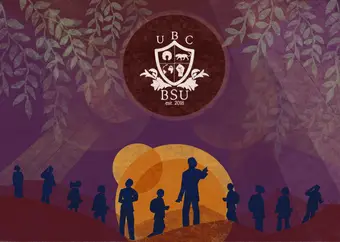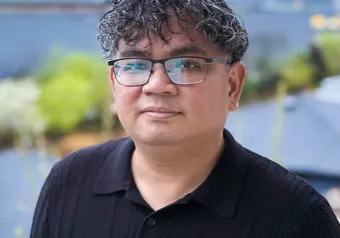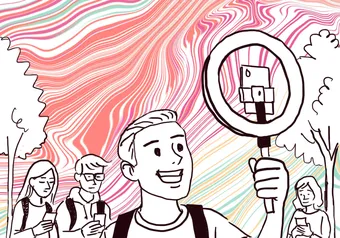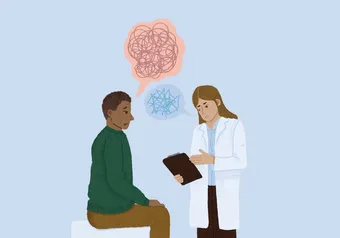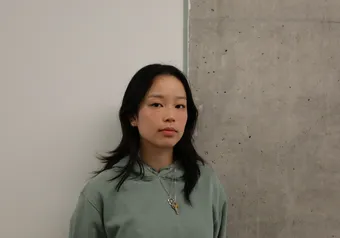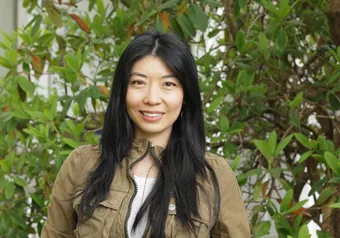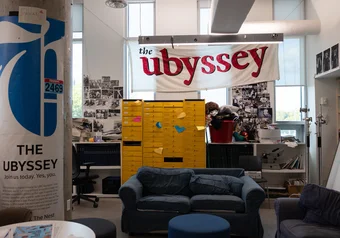It was Savannah Sutherland’s first month back on campus since they graduated in May 2020. Main Mall was lined with booths of UBC clubs and resources for the 2022 Imagine Day as thousands of students crowded in. Across the sea of students, Sutherland spotted a familiar booth and was filled with pride.
As soon as they could take a break from boothing for the Sexual Assault Support Centre, they ran across Main Mall to the Black Student Union’s (BSU) booth. They said to the students working the booth, “Oh my God, guys! You don’t know who I am, but I used to be [a BSU] President!”
Sutherland wasn’t just a BSU president, but one of the founding members of the BSU.
Sutherland teared up recalling the day. “I was so proud of what we’ve created. And I am so happy that students … continue to find value in it,” they said. “It’s one of those things that kind of feels bigger than you.”
2016: UBC is an isolating place for Black students
Sutherland remembered arriving at UBC in 2016 and, for the first time, being the only Black person in the room. Having grown up in the United Arab Emirates, they were used to being surrounded by other people of colour. But at UBC, being the only Black person in most spaces on campus felt isolating and made it challenging to find belonging.
Although many Black students report often being the only Black person in UBC spaces, it is impossible to say what per cent of UBC students identify as Black. UBC has historically not collected race-based student enrollment data, although the UBC Student Demographic Data Project aims to change that. There is, however, race-demographic data that shows Vancouver has a very small percentage of Black residents compared to other major cities in Canada. Black people make up about 4.3 per cent of the Canadian population, but that number drops to 1.6 per cent in the Greater Vancouver area.
As Sutherland settled into their first year, they began to find that a disproportionate number of conversations were centred around their appearance.
“It feels really weird when it’s just comments on your physical appearance,” they said. “And very rarely are you having any other conversation with people about any other aspects of you, except for the parts of you that make you Black.”
2017: Black students are not a monolith
By the time they were in their second year, Sutherland had sought out all possible opportunities to connect with other Black students. They had joined the African Awareness Initiative (AAI), a club founded in 2002 which was instrumental in a number of initiatives to advance discourse regarding Africa on campus. One of those advancements was the creation of the African Studies Minor, which Sutherland had declared. They also joined the Caribbean African Association (CAA) in their first year, but the club fizzled out as the year went on.
Sutherland was starting to make friends with other Black students, many of them international themselves, and found they were feeling alienated too. They all shared stories about how hard it was to find other Black students at UBC.
“We were finding it very hard to make friends and connect … feel a sense of home … a sense of belonging,” they said. It became clear that for Sutherland and their friends, neither the CAA nor the AAI were expansive enough to incorporate all of their diverse identities. What they did have in common was their Blackness.
So, Sutherland, together with other founding members – Gavin Gordon, Alexandria Rodriques and Haydn Reid – came to the decision to create a Black Student Union. A BSU would enable them to build a community where every Black student, irrespective of their ancestry, could feel represented and accounted for. “That was the initial thing that created the BSU … a need to just be in community with other Black people,” said Sutherland.
From the beginning, the BSU has honoured the reality that Black students are not a monolith.
2017: Forging a path ahead
Thinking back to those days, Sutherland is sure there must have been things they feared, but above all, they remember being intoxicated with the possibility of bringing Black students together in the face of overwhelming community fragmentation. Ideas about what the club was and could be were flying around constantly among those involved. The BSU was a radical idea.
The AMS’ Operations Committee Policy Manual states that clubs must demonstrate that they will not have the effect of promoting discrimination based on race or ethnic origin. In other words, no AMS club can be exclusionary. So the founding members needed to establish a justification for a club that was specifically based on race. Clubs like the CAA and the AAI did not face this issue as they were based on nationality, not race.
The BSU founders were not able to use race-based enrolment data to support their justification as it does not exist. They additionally needed to demonstrate the likelihood of future membership and financial stability, just like any new AMS club — something that demographic data would have been helpful for.
“We had to do all of that resourcing ourselves,” Sutherland recalled.
Reid, who would become the club’s first treasurer, was adept at navigating the administrative requirements for constituting a new AMS club. Rodriques, who would become the first VP of media and marketing for the BSU, was exceptionally effective in getting the word out about the club. Sutherland and Gordon, who became the first co-presidents, worked out how to explain that a club based on Black identity was inclusionary, not exclusionary. The group also took advantage of connections they had within the AMS, like Will Shelling — then-associate vice-president external affairs — and then-AMS President Chris Hakim.
The founders had also been granted permission to co-opt the former CAA’s social media account for use by the BSU, which was vital in getting the word out to more students. Members of the AAI also supported where they could. It was a community effort.
“The BSU wouldn’t have existed without the CAA and the AAI,” Sutherland said.
2018: BSU’s Inaugural General Meeting
About 75 Black students gathered in the Michael Kingsmill Forum in the Nest on the evening of November 13, 2018. Nobody in that room could remember seeing that many Black students gathered in one room at UBC. The energy in the forum was dazzling. There were more people in attendance than there were seats to hold them.
The students had assembled for the BSU’s Inaugural General Meeting, where they would vote on the club constitution, bylaws and the first co-presidents and treasurer. It was Sutherland’s third year, and they, along with the rest of the founding team, were seeing the culmination of their hard work. “The vibes were so open and so freeing and compassionate because everyone was so excited to see another Black person,” Sutherland said.
Shelling was one of the attendees. He remembers the “unbridled joy” of that night. “[We were] trying to run a meeting, but also laughing and enjoying ourselves along the way,” he said.
The BSU would meet again two weeks later to vote on four vice-president positions and the first year and graduate representatives.
Maia Wallace, then an eager and motivated first-year student, had recently heard about the new club from Sydney Henry, an older student involved in founding the club. She decided to attend the elections meeting, even though she wasn’t quite sure what the purpose of the BSU was.
When she walked into the elections meeting, Wallace instantly realized that she had never been around so many Black people at UBC before. Her initial uncertainty disappeared in an instant. She immediately knew the BSU was something she needed to be a part of. “I’m big on intuition, and I just had that gut feeling,” she said to The Ubyssey.
Right then, she decided to run for the first year representative positions. She made up her election speech on the spot, starting with the statement, “The definition of racism is that it’s a social construct, but the consequences are real.” Wallace recalled that you could hear a pin drop in the room while she spoke. Wallace was elected.
In the months following those first two meetings, the club’s new executive team focused on strengthening the inclusive and expansive community. “Our focus really was on building community,” Sutherland recalled. “It’s hard to do much else if you don’t have a community to back you.”
Wallace was instrumental in gathering younger students to join the club. She made a group chat with 50 first-years and planned events for them every month (using her parent’s credit card).
The BSU received the AMS ‘Best New Club’ award at the All Presidents’ Dinner.
2020: ‘Catching the parts we could hold with our hands’
While the 2018/19 academic year ended with an award, the 2019/20 year ended in a pandemic. It was May 2020, the reality of the COVID-19 pandemic was sinking in, and then the world was rocked by the murder of George Floyd. Wallace had recently been elected as BSU co-president, alongside Tracy Odhiambo, for the 2020/21 academic year.
Wallace and Odhiambo found themselves thrust into a position of power on the institutional stage. They were constantly being asked to assume the role of anti-racism consultants for UBC. People were finally listening to Black voices. “That’s when we were immortalized as a club,” Wallace said.
The club wasn’t supposed to be an anti-racism organization; they were supposed to be a group of students who gathered for the sake of gathering.
“It was like the world was falling on us, and [we where] catching the parts that we could hold with our hands,” Wallace recalls. “And rebuilding.”
2021: ‘Picking up the pieces’
Aisha Ismail started at UBC in the fall of 2020. The BSU had transitioned entirely online, and efforts turned to combatting community fragmentation. They shifted recruitment to take advantage of the new reality that incoming students were primarily meeting peers online.
The BSU’s online presence enabled Ismail to meet other Black students. There were group chats among first years and speed dating-style Zoom gatherings, but it was difficult to make meaningful connections with the physical separation.
“Obviously, you still had the Zoom awkwardness,” Ismail recalls, “but you knew that everyone there … wanted to be a part of the community.”
During the 2021/22 school year, with COVID-19 precautions fluctuating, the BSU continued to have primarily online meetings. Ismail was elected as VP internal.
“We were still picking up the pieces of what COVID[-19] did,” Ismail said.
Looking forward and looking back
When Sutherland happened upon the BSU booth at Imagine Day, they were transported back to the feelings of excitement and pride from when this all started. “Through all of it we have still persisted … we are still resilient and building and maintaining community,” Sutherland said. “That’s really the part that … feeds your soul.”
Since the fall of 2022, the BSU is finally back to full-time in-person operations. Awareness of the club is rising again, thanks to the new Black Student Orientation and the opportunity to connect with students in person at events like Imagine Day.
Currently, the executive team’s efforts are divided between organizing events and advocating for sustainable support for Black students on campus. In everything they do, they continue to have the same overarching goal that the BSU’s founders set out with: bringing together Black students at UBC.
The current executive team recognizes they may not accomplish all their goals by the time their tenure ends, but they’re focused on laying a strong foundation for future teams to build upon.
After four and a half years, the BSU has never forgotten its founding promise.
“That pulse continues whether we’re in that kinship together, or whether we’re outside of it,” Wallace said, reflecting on where the BSU is today. “[The community] exists, and it lives and breathes. And it becomes this self-living, self-breathing machine.”
First online
Share this article


